Swiss cuisine is a tantalizing blend of German, French, and Italian culinary traditions, offering a rich tapestry of dishes from hearty cheese fondue and raclette to crispy rösti. Known for its farm-to-table approach and high-quality ingredients, Swiss food is a true embodiment of Switzerland’s natural abundance and historical influences.
Welcome to a culinary adventure that’s as breathtaking as the Alpine peaks of its homeland. Indulge your senses in the hearty, flavorful diversity that is Swiss cuisine. This is more than just a taste journey—it’s a rich tapestry of centuries-old traditions, farm-fresh ingredients, and an insatiable love for good food. Here, we’ll delve into the soul of Switzerland, painting a delicious portrait of its culinary wonders and sharing sumptuous recipes that will transport you straight to the heart of the Alps.
So whether you’re an adventurous foodie, a home cook, or simply curious about Swiss cuisine, this is your essential guide to understanding and savoring its delights. Welcome to the world of fondue, raclette, rösti, and so much more—welcome to the world of Swiss cuisine.
1. Cheese Fondue
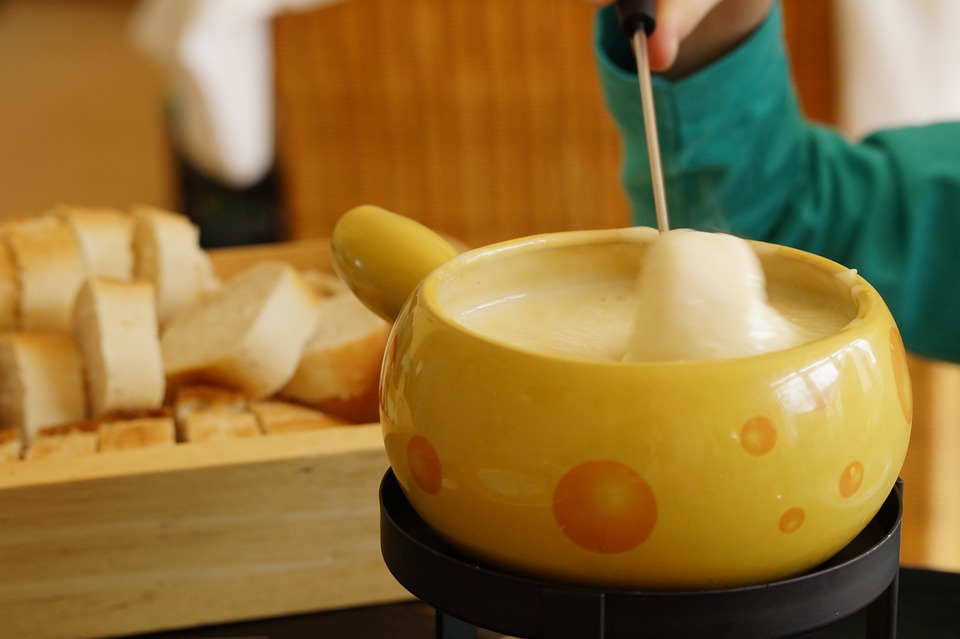
Surely, the most epic cheese there is. That’s why it makes our top choice of traditional Swiss food you need to try. Fondue is a Swiss melted cheese dish served in a communal pot over a portable stove heated with a candle or spirit lamp and eaten by dipping bread into the cheese using long-stemmed forks.
The easiest recipe for Swiss fondue is mixing wine, garlic, and lemon juice in a ceramic pot over medium-low heat, or you can even use a heavy saucepan instead. Then, you add the cheese to the simmering liquid a little at a time, stirring well between each addition to ensure a smooth fondue. Sounds delicious even when explained, right? Imagine tasting it.
2. Tarts and Quiches
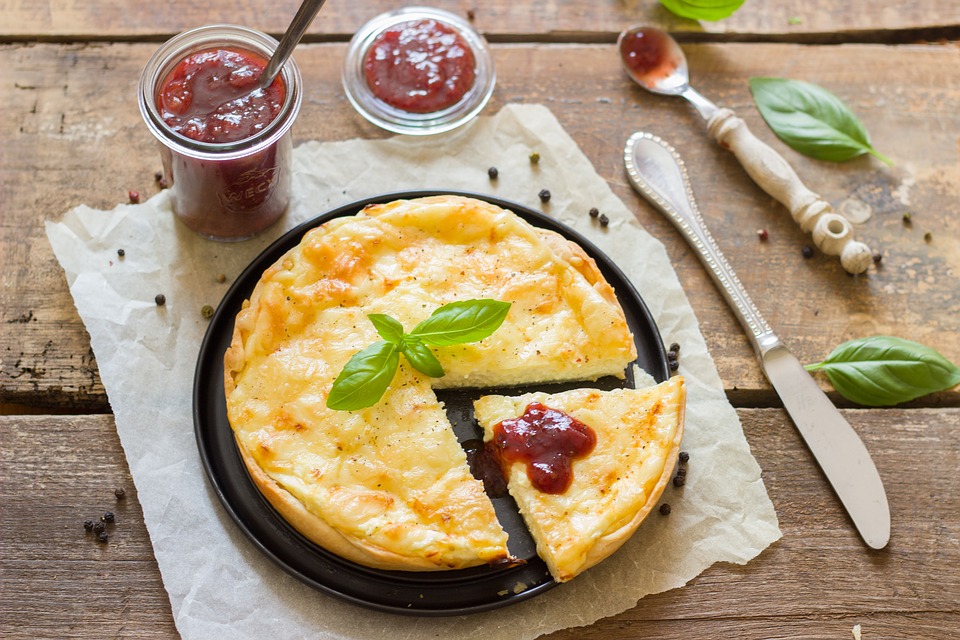
The quiche and Swiss cheese tarts are only superficially related. Both have pastry, cheese, and custard; however, the quiche is really about the custard, whereas the Swiss tart is more about cheese.
Swiss cheese tarts come in all sizes, yet the small ones are more petite and even eye-pleasing. You can pick a little one up and eat it picnic-style. Little cheese tarts look so cheerful and tasty on small, pretty plates. The quiches can also be loaded with fish, meat, or vegetables, whereas tarts can be topped with different flavors, from onion to sweet apple. These dishes are typical for anniversaries and birthdays.
3. Landjager
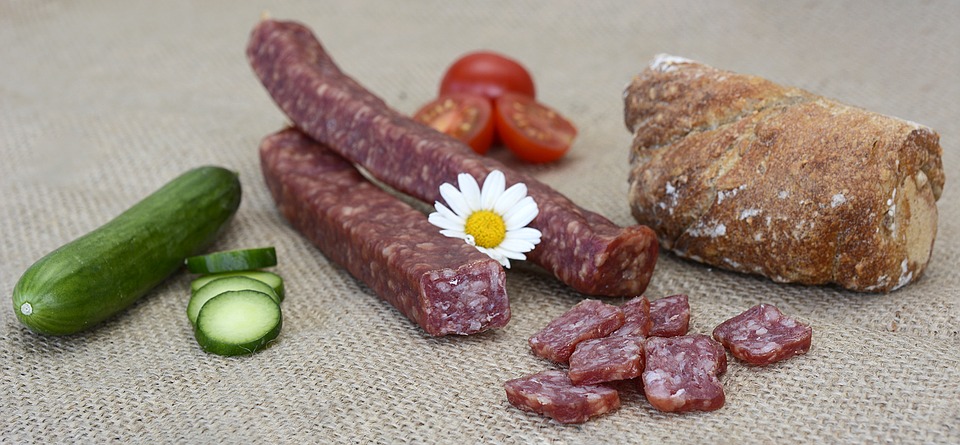
All those mountains and trails to hike in Switzerland, one has to have some snacks on the way up, right? This is exactly where the semi-dried sausage (Landjäger) comes in. This traditional Swiss snack is prepared with a combination of pork, beef, lard, red wine, sugar, and selected spices. The name landjäger means land hunters, referring to the fact that these sausages are especially convenient and popular among backpackers and hunters who carry them while traveling.
4. Älplermagronen (Alpine Macaroni)
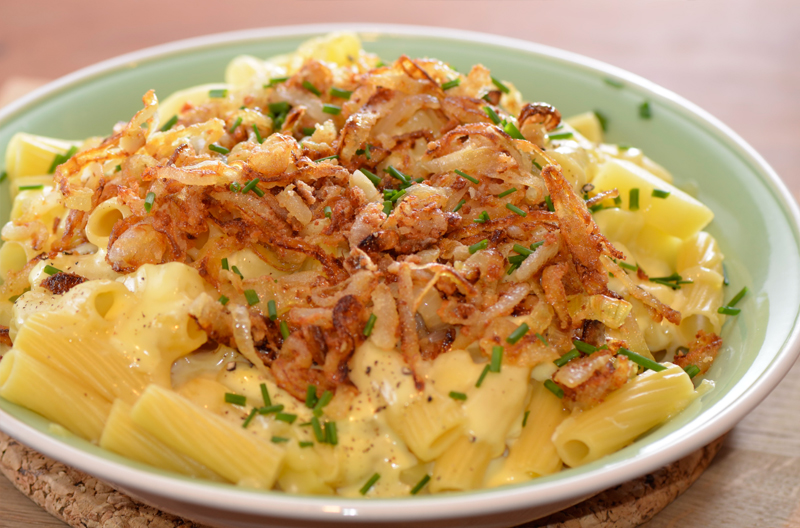
When it comes to hearty Swiss comfort food, Älplermagronen, also known as Alpine Macaroni, holds a special place. This dish, a heartwarming staple in Swiss Alpine cuisine, ingeniously combines pasta, potatoes, cheese, onions, and often, a side of apple sauce, providing a delightful play of textures and flavors in every bite.
The traditional recipe starts with macaroni and diced potatoes boiled together until tender. This unique pasta-potato combination is then layered in a casserole dish with generous amounts of creamy, melted Swiss cheese. The dish is baked until the cheese bubbles and turns golden, yielding a scrumptious, gratin-like texture. Meanwhile, caramelized onions are prepared and served as a garnish, lending a sweet and slightly tangy element that beautifully contrasts the savory, rich components. Often, Älplermagronen is served with a dollop of apple sauce on the side, adding a touch of sweetness that complements the hearty meal.
Originally a sustenance meal for Swiss herdsmen in the Alps, Älplermagronen has become a cherished national dish, appreciated for its simplicity, affordability, and above all, its soul-satisfying taste. Whether served in a high-end restaurant or cooked at home, this Swiss Alpine Macaroni is a testament to Switzerland’s culinary heritage and its love for simple, wholesome ingredients.
5. Raclette
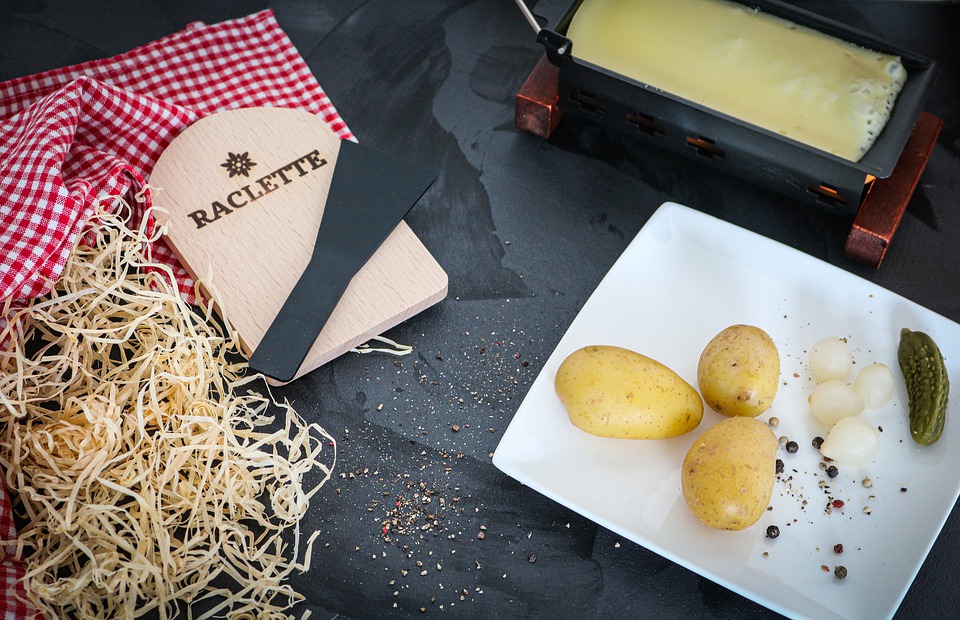
Behold, cheese lovers. Another jaw-dropping cheesy dish of Switzerland. Raclette is a semi-hard cheese made from Alpine cow milk. Historically, it has been the main food of peasants who lived in the regions of Valais. An entire wheel of cheese would be held up in front of a fire, and as the cheese melted, it was scraped off onto a plate to be eaten. Thus, the name derives from the French word racler, meaning, to scrape.
Nowadays, slices of raclette are melted and escorted with small potatoes cooked in their skin, onions, pickled gherkins, and vegetables.
6. Rosti
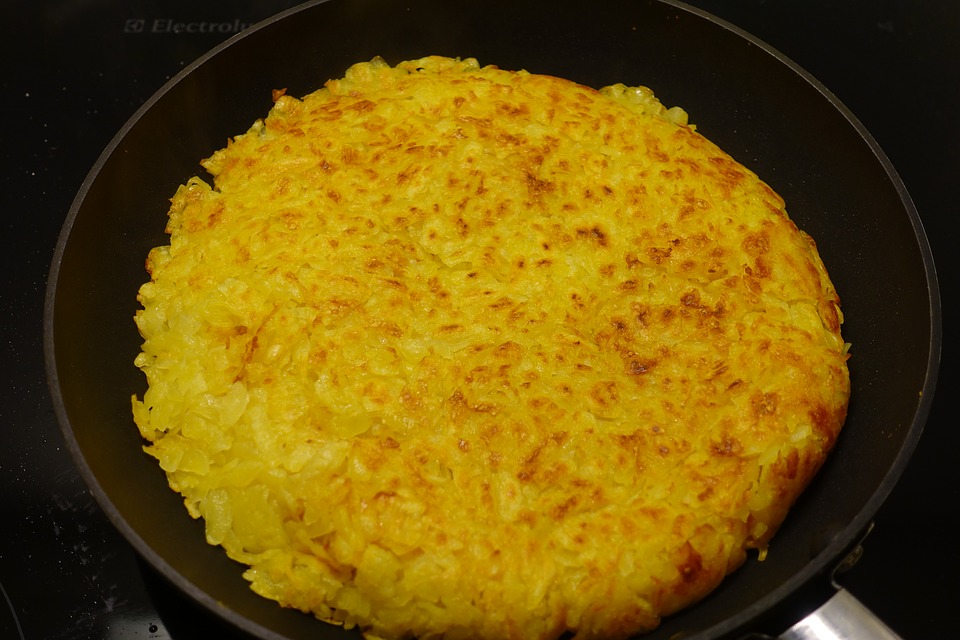
Locally known as rööschti, this Swiss dish consists mainly of potatoes but in the style of a fritter. Originally, it used to be a breakfast dish historically eaten by farmers in the canton of Bern. That’s why the name of it was initially röstis bernois. However, nowadays, it features on digital menus across the country and is eaten all over Switzerland. Rosti potatoes are legit known as the Swiss version of the classic potato pancake.
The secret to the perfect rosti is cooking the first side covered with a lid or foil until crispy, then carefully turning and cooking the second side without the lid to golden perfection! At least that’s what people say in the Swiss country.
7. Saffron risotto
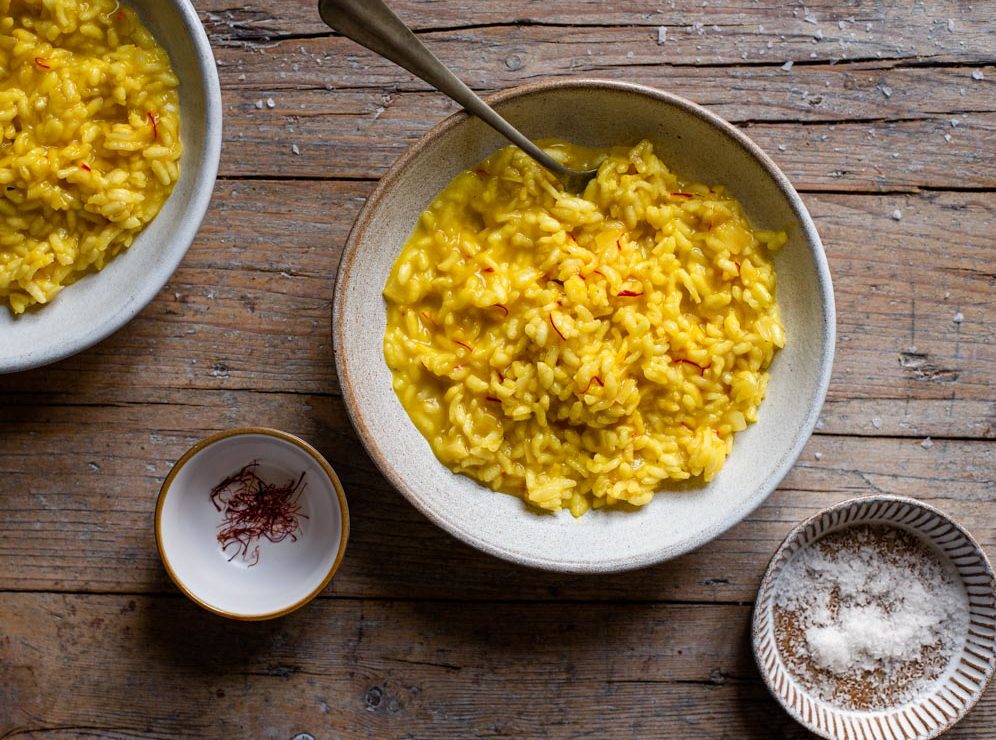 Saffron risotto, a culinary gem hailing from the Swiss canton of Ticino, brilliantly encapsulates the fusion of Italian influence and Swiss refinement in the region’s cuisine. The Swiss food and trekking expert from Bookatrekking specializing in hiking holidays in Austria says that traditionally known as Risotto alla Milanese in Italy, this dish has been adapted by the Swiss and holds a revered place in the Ticino’s gastronomic landscape.
Saffron risotto, a culinary gem hailing from the Swiss canton of Ticino, brilliantly encapsulates the fusion of Italian influence and Swiss refinement in the region’s cuisine. The Swiss food and trekking expert from Bookatrekking specializing in hiking holidays in Austria says that traditionally known as Risotto alla Milanese in Italy, this dish has been adapted by the Swiss and holds a revered place in the Ticino’s gastronomic landscape.
The preparation of Swiss saffron risotto starts with a soffritto of onions sautéed until they become soft and translucent. Arborio rice, a starchy short-grain variety, is then added and toasted lightly. This step helps seal in the rice’s flavor and primes it for the subsequent addition of a splash of good-quality white wine.
The true artistry of the dish lies in the gradual addition of warm broth, coaxing the rice to slowly absorb the liquid and release its starch, culminating in a creamy, satisfying texture. The defining ingredient, saffron, is introduced during this stage. Its vibrant threads infuse the dish with a captivating aroma, an earthy flavor, and an alluring golden hue.
Final touches often include a hearty sprinkle of Parmesan cheese, amplifying the risotto’s savory depth, and sometimes a knob of butter for extra richness. The result is a Swiss saffron risotto that is creamy yet al dente, luxuriously rich, and imbued with the exotic essence of saffron.
Whether it’s savored as a standalone dish, served alongside a succulent osso buco, or enjoyed at a family gathering, Swiss saffron risotto offers a delectable slice of Ticino’s culinary heritage, epitomizing its love for simple ingredients transformed into exquisite fare.
8. Malakoff
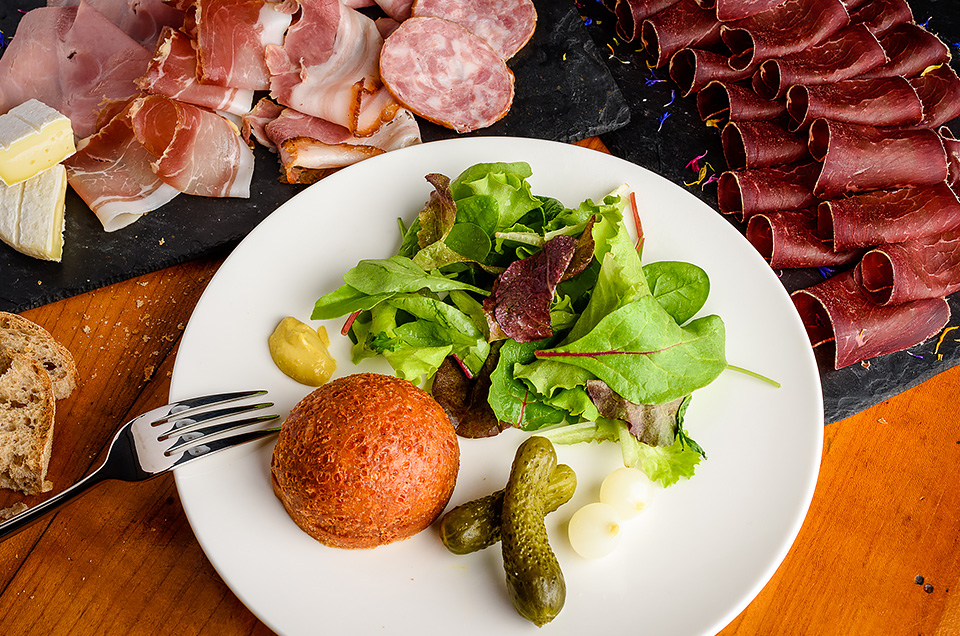
A Malakoff is a ball of fried cheese typically found in Western Switzerland, more specifically in the villages of Eysins, Begnins, Bursins, Luins, and Vinzel on the shores of Lake Geneva. The recipe was brought by the Swiss mercenaries who joined the Crimean War under the French-British forces fighting against Russia. This Swiss cheese bread was particularly named after the major battle of Malakoff that resulted in the fall of Sevastopol, thus ending the battle.
The malakoff is typically served as a first course and enjoyed with served cornichons, pickled onions, and mustard. Surely, wine is its best companion!
9. Polenta (Cornmeal)
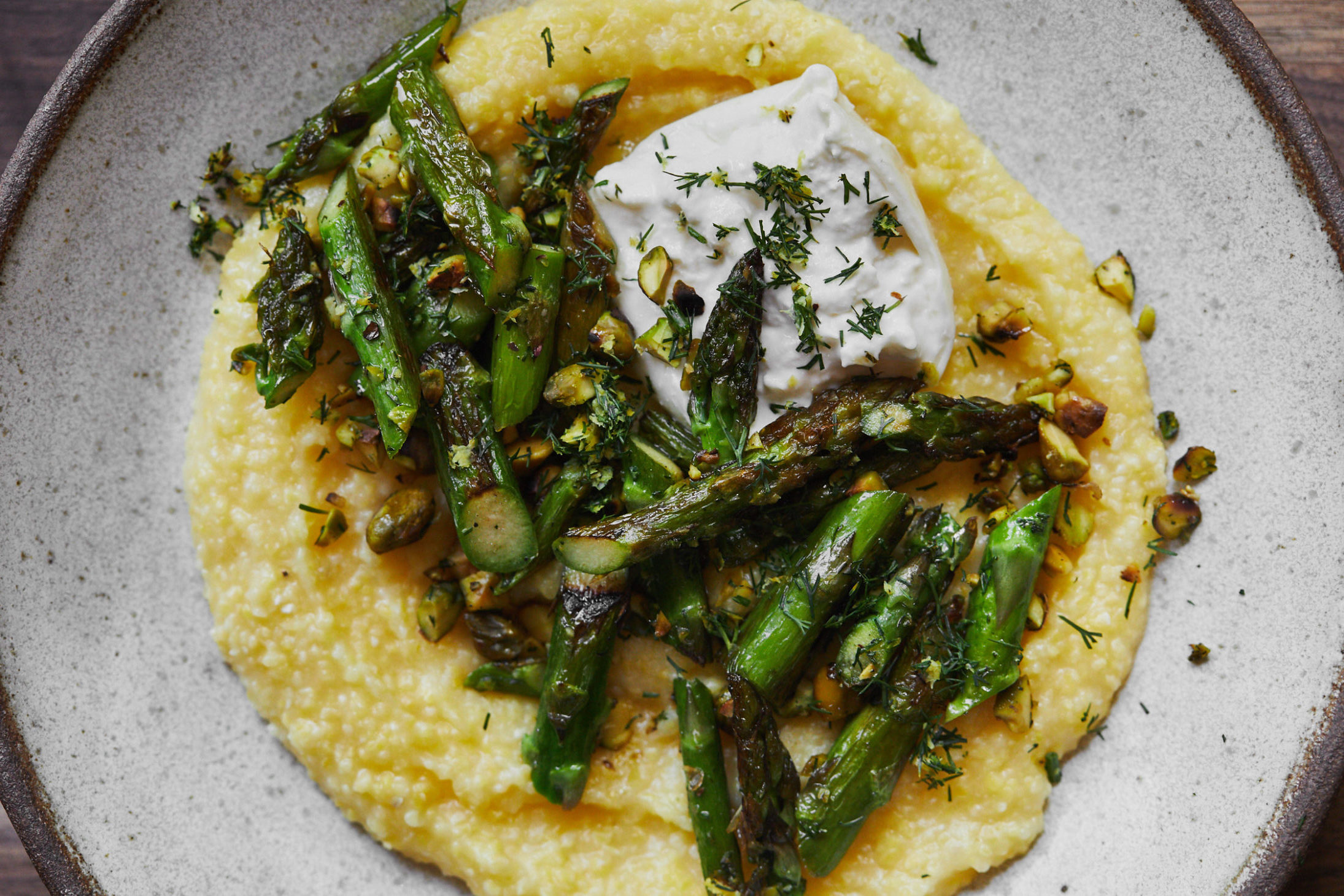
Polenta is a yellow cornmeal dish that is cooked over low heat until it becomes a delicious, homogenous mash. Along with chestnuts and risotto, this dish also belongs to the traditional peasant foods of Ticino. It can be eaten out of a bowl or spread on a wooden board, cooled, and cut with a piece of thin thread. You can serve it with butter, cheese, a stew, a sauce, or simply a splash of cold milk. Once considered food for the poor, but now polenta is basically an identifying dish of traditional Swiss cuisine.
10. Zürcher Geschnetzeltes
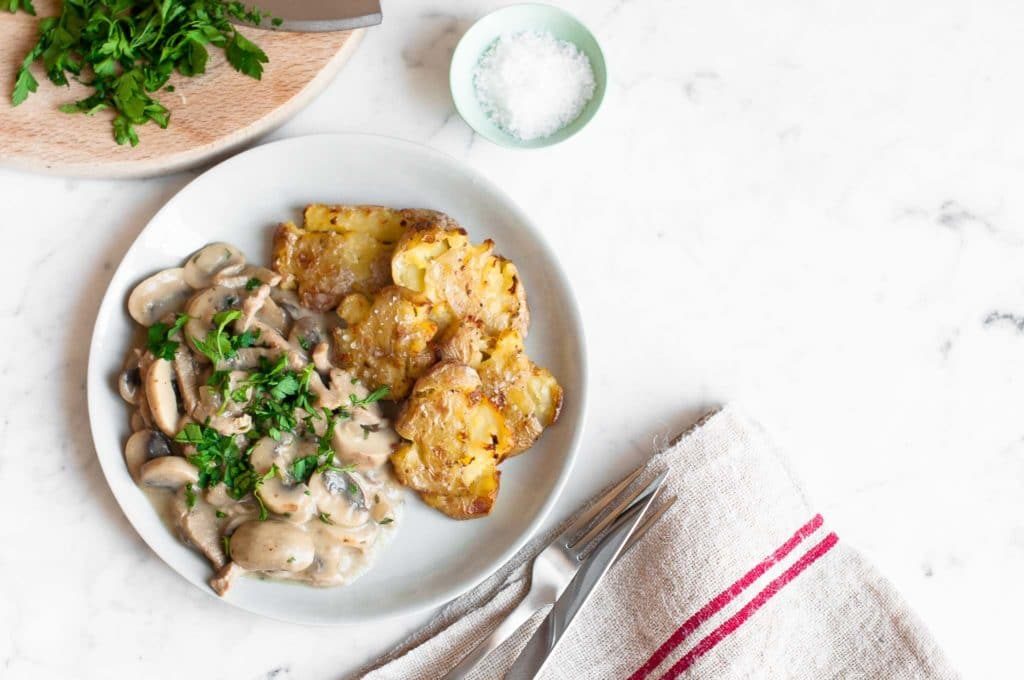
Zurich Ragout, or Zürcher Geschnetzeltes, is a stew recipe in a white sauce, made with mushrooms and white wine. It contains many of the typical Germanic flavorings, including parsley and lemon zest.
This traditional dish might look delicate, but it’s really easy to make, finding its way into your heart through your stomach. Veal loin is traditionally used, but pork loin may be substituted. It is usually served with Rösti (Swiss Hash Browns) and white Swiss wine (or try a Pinot Grigio or Grüner Veltliner).
The first mention of Zürcher Geschnetzeltes is in a cookbook from 1947. That recipe includes ingredients such as sliced veal strips, white wine, cream, and demiglace. Some contemporary recipes may also call for mushrooms and sliced veal kidneys.
11. Birchermüesli
A testament to the Swiss philosophy of simplicity and wellness, Birchermüesli is a beloved breakfast dish that’s as nourishing as it is delicious. Pioneered by Swiss physician Maximilian Bircher-Benner in the early 20th century, Birchermüesli was initially designed as a health food for his patients. Today, it’s a staple in Swiss households and a popular choice for breakfast or a light meal worldwide.
Birchermüesli is a refreshing medley of rolled oats soaked overnight in a combination of milk or yogurt, resulting in a soft, creamy texture. The magic of the dish lies in its versatility, allowing it to be embellished with a range of nutritious add-ons. Fresh or dried fruits, nuts, and seeds are often incorporated, contributing a variety of textures and flavors.
Traditionally, grated apple is a key ingredient in Birchermüesli, with the skin left on to preserve the fruit’s nutritional value. A touch of lemon juice is added to keep the apple from browning and to lend a zesty freshness that balances the dish’s natural sweetness.
Birchermüesli can be customized to suit one’s preference or dietary needs, and it is as popular in its original form as it is in its many adaptations. Whether enjoyed as a quick, energy-packed breakfast to kick-start the day, a nutritious snack, or a light, guilt-free dessert, Birchermüesli is more than just a meal—it’s a celebration of Swiss culinary ingenuity and their unwavering commitment to health and wellbeing.
12. Swiss Chocolate
When it comes to luxuriously smooth and delightfully rich sweets, Swiss chocolate undeniably stands among the world’s finest. With a reputation that spans centuries, Swiss chocolate has earned global admiration, not just for its superior quality and taste, but also for the skill, passion, and meticulous precision that Swiss chocolatiers put into every piece.
Switzerland’s love affair with chocolate dates back to the early 19th century, and it has since evolved into an art form, an industry, and a national symbol. Swiss chocolatiers have been instrumental in pioneering several innovations that have shaped the chocolate industry, including the invention of milk chocolate by Daniel Peter and the creation of the conching process by Rodolphe Lindt, which gave chocolate its irresistibly smooth texture.
Swiss chocolate is often characterized by its high cocoa content, its use of high-quality, whole milk powder, and its unparalleled creamy texture. This is a result of rigorous quality standards and the use of traditional methods that have been refined over generations.
Whether it’s a velvety milk chocolate, a rich, bitter dark chocolate, or a creamy, nut-infused variant, each type of Swiss chocolate offers a unique sensory experience. Indulging in Swiss chocolate is more than just satisfying a sweet tooth—it’s immersing oneself in a moment of sheer pleasure, one that resonates with the heritage and craftsmanship that the Swiss are renowned for.
From globally recognized brands like Lindt, Toblerone, and Nestlé, to small, artisanal chocolatiers crafting exclusive, hand-made creations, Swiss chocolate caters to every discerning palate. Its undeniable allure makes it a cherished souvenir, a coveted gift, and a delightful treat enjoyed by chocolate lovers worldwide.
13. Swiss Cheese
Nothing quite symbolizes Swiss culinary excellence like its iconic cheese. With over 450 varieties to its name, Swiss cheese is an integral part of the country’s cultural fabric and gastronomic legacy. From the molten fondue pots in bustling city bistros to the cheese cellars in remote Alpine dairies, Swiss cheese pervades every aspect of the nation’s culinary scene.
Switzerland’s diverse climate and topography provide the perfect conditions for creating an extraordinary range of cheeses. Each variety of Swiss cheese carries a unique identity, dictated by regional nuances, the type of milk used, and the age-old cheese-making techniques passed down through generations.
Among the pantheon of Swiss cheeses, Emmental, often referred to as Swiss cheese in many countries, is perhaps the most globally recognized. Characterized by its large, iconic holes or ‘eyes’, Emmental boasts a slightly sweet, nutty flavor and a firm, smooth texture. Gruyère, another beloved Swiss cheese, is known for its rich, creamy texture and versatile flavor that intensifies with aging. Then, there’s Appenzeller, a semi-hard cheese steeped in a secret herbal brine, giving it a distinctive, tangy taste.
Raclette, a cheese celebrated in its namesake dish, melts to perfection, resulting in a creamy, velvety cheese that is a delight to savor. Moreover, Switzerland’s diverse cheese portfolio includes softer cheeses like the creamy Vacherin Mont d’Or and pungent Sbrinz, an extra hard cheese often used similarly to Parmesan.
Swiss cheese is celebrated not only for its impressive variety and distinct flavors but also for its quality. The use of pure, untreated milk, traditional cheese-making practices, and strict quality controls ensure every wedge, wheel, and slice of Swiss cheese meets the highest standards.
Whether it’s enjoyed in a cheese fondue, grated onto a rösti, paired with a fine wine, or savored just as it is, Swiss cheese offers a gastronomic experience that is deeply rooted in Switzerland’s culinary heritage and continues to be an essential part of its cuisine.
14. Riz Casimir
Swiss cuisine, while steeped in tradition, is not immune to global influences. One of the most intriguing and delightful examples of this culinary fusion is Riz Casimir, a dish that seamlessly blends Swiss precision with the exotic flavors of curry and tropical fruits.
Invented by Swiss restaurant chain Mövenpick in the 1950s, Riz Casimir offers a unique taste experience that reflects the growing global food influences of the time. This dish presents an unexpected yet harmonious medley of flavors, featuring tender pieces of chicken smothered in a mild, creamy curry sauce served atop a bed of fluffy white rice.
What sets Riz Casimir apart from other curry dishes is its garnish of tropical fruits. Chunks of pineapple, banana, and sometimes cherries or peaches, are scattered over the curry, introducing a burst of sweetness that beautifully contrasts with the warmth of the curry. These tropical elements echo the diverse flavor profiles found in some Asian cuisines while adding a uniquely Swiss touch.
Despite its international influences, the dish remains true to Swiss culinary philosophy—every ingredient, from the locally sourced chicken to the meticulously cooked rice, reflects the nation’s commitment to quality and attention to detail.
Riz Casimir, a curious Swiss-Asian fusion dish, is a testament to Switzerland’s culinary adaptability and willingness to experiment with global flavors. Whether enjoyed in a bustling city restaurant or prepared at home, Riz Casimir takes you on a delightful culinary journey, from the snow-clad peaks of the Swiss Alps to the vibrant spice markets of Asia.
15. Zuger Kirschtorte
Zuger Kirschtorte, or Zug Cherry Cake, stands as a delightful testament to Swiss baking finesse. Hailing from the town of Zug, known for its high-quality cherry brandy or ‘kirschwasser,’ this sophisticated cake embodies the fine balance of taste, texture, and tradition, making it a revered specialty in Swiss pastry-making.
Zuger Kirschtorte is not your typical fruitcake. At the heart of this dessert is a light, airy genoise sponge, split into layers and generously moistened with kirschwasser. These layers are then sandwiched with a smooth, buttery cream, subtly flavored with more kirschwasser, and a thin layer of pureed cherries, introducing a burst of fruitiness that complements the richness of the cream.
The cake’s exterior is draped with a thin layer of marzipan, adding a mild almond undertone and a sophisticated finish. The top is typically dusted with powdered sugar and decorated with an elegant chocolate design, while the sides are adorned with roasted almond flakes.
The result is a multi-layered symphony of flavors and textures— the lightness of the sponge, the creaminess of the buttercream, the sweet-tart cherry flavor, and the delicate marzipan all come together beautifully in every bite. The real star, however, is the kirschwasser, lending an understated cherry aroma and a distinct, warming aftertaste that beautifully ties all the elements together.
While the Zuger Kirschtorte requires meticulous precision and patience to prepare, the result is a dessert that is a visual treat, a delight to the palate, and an ode to Zug’s cherry brandy-making tradition. Whether enjoyed at a celebration or savored with a cup of coffee, Zuger Kirschtorte promises a delightful slice of Swiss pastry artistry.
16. Bündner Nusstorte
Immersed in the culinary traditions of Switzerland’s canton of Graubünden, the Bündner Nusstorte stands as a delicious symbol of the region’s rich gastronomic heritage. This sumptuous nut tart, also known as Engadiner Nusstorte, beautifully captures the flavors and textures of the Swiss Alps, making it a beloved classic in the Swiss dessert repertoire.
At the heart of Bündner Nusstorte is a filling that’s a caramel lover’s dream – a luscious concoction of sugar, cream, and honey that is simmered until it develops a golden hue and a rich, sweet flavor. This caramel base is then studded with generous amounts of chopped walnuts, resulting in a delightfully crunchy texture and a nutty flavor that beautifully complements the sweetness of the caramel.
The tart’s filling is encased in a delicate, buttery shortcrust pastry. The dough is rolled out, lined into a tart pan, filled with the nut-caramel mixture, and then topped with a second layer of pastry. This creates a parcel that holds within it a delightful contrast of textures – the crisp, flaky crust perfectly balancing the gooey, crunchy filling.
The final touch to the Bündner Nusstorte is its distinctive pattern created on the top layer of the pastry, often showcasing the baker’s personal touch and creativity. Once baked to a golden-brown perfection, the tart becomes a delicious harmony of buttery pastry, sweet caramel, and earthy walnuts.
Bündner Nusstorte is a simple yet satisfying dessert, an embodiment of Switzerland’s fondness for using local, high-quality ingredients and traditional baking methods. Whether it’s enjoyed as an after-meal treat, served with afternoon tea, or savored after a day of skiing in the Alps, this delectable nut tart offers a sweet taste of Swiss culinary heritage.
17. Meitschibei
The Swiss baking tradition is brimming with delightful confections, and among them, Meitschibei—a horse-shaped pastry hailing from the city of Bern—holds a special place. With its unique shape and flavorful filling, Meitschibei is a beloved treat in Swiss patisseries and a testament to the country’s inventive baking culture.
At first glance, Meitschibei is charmingly reminiscent of a horse’s leg, which is how it got its name—’Meitschibei’ translates to ‘maiden’s legs’ in Swiss German. However, it’s not just the shape that captivates; the flavors within this pastry are equally delightful.
The heart of a Meitschibei is its filling— a delectable blend of ground hazelnuts or walnuts, sugar, and a touch of kirsch, a cherry-based spirit. This nutty, slightly boozy mixture is wrapped in a shortcrust pastry, creating a delightful contrast between the crumbly, buttery crust and the moist, flavorful filling.
To achieve the characteristic shape, the filled pastry is folded over, sealed, and then cut at an angle at the ends. A few diagonal slits are made on the top, allowing the nut filling to peek through during baking and creating an attractive pattern. The result is a golden, enticing pastry that’s a treat for both the eyes and the palate.
Whether enjoyed as a companion to a cup of coffee, a sweet afternoon pick-me-up, or a delightful end to a meal, Meitschibei embodies the creativity, craftsmanship, and comforting flavors intrinsic to Swiss baking. This delightful pastry, with its playful shape and traditional flavors, offers a sweet glimpse into Bern’s rich culinary heritage.
Embrace the Journey Into Swiss Cuisine
As we have journeyed through the diverse landscape of Swiss cuisine—from the comforting warmth of Fondue and the hearty goodness of Älplermagronen to the vibrant fusion of Riz Casimir and the sweet indulgence of Zuger Kirschtorte—it’s clear that Switzerland offers a culinary adventure like no other. Immersing yourself in the rich world of Swiss cuisine not only opens up a limitless number of culinary delights, but also provides a great opportunity to understand food values. The example of a nutrition report emphasizes the value of including fresh local products, which is a hallmark of Swiss culinary traditions. It also emphasizes the balance between pleasure and health, and shows how traditional dishes can meet modern nutritional guidelines.
While Swiss recipes are obviously influenced by dishes from neighboring countries, most recipes have become distinct. Every dish tells a story, every flavor captures a part of the Swiss heritage, and every ingredient speaks to the country’s commitment to quality and tradition.
But to truly appreciate Swiss cuisine, one must not only read about it; one must taste it. So, we encourage you to immerse yourself in this culinary world. Try your hand at cooking some of these traditional dishes at home, visit your local Swiss restaurant, or better yet, plan a trip to Switzerland to savor these delicacies in their authentic setting
Frequently Asked Questions (FAQs) about Swiss Cuisine
What is in Swiss food?
Swiss cuisine is characterized by its high-quality, locally-sourced ingredients. Dairy products, such as cheese and milk, play a significant role, given Switzerland’s strong dairy farming tradition. Other staple ingredients include potatoes, meats (particularly pork, beef, and veal), and a variety of grains. Swiss cuisine also features an abundance of fresh fruits and vegetables, thanks to the country’s diverse climate and fertile soil.
What is Switzerland’s famous food?
Switzerland is famous for a variety of dishes. Fondue, a communal dish made with melted cheese and wine, is one of its most iconic foods. Other well-known Swiss dishes include Raclette, Rösti, and Zürcher Geschnetzeltes. Swiss pastries, such as the Bündner Nusstorte and Zuger Kirschtorte, are also globally recognized. Furthermore, Swiss chocolate and cheese have garnered international acclaim for their exceptional quality and taste.
What does Swiss mean in food?
In food terminology, the term ‘Swiss’ usually refers to a dish that originated from or is commonly associated with Switzerland. It can also indicate the use of Swiss-style or Swiss-made ingredients, like Swiss cheese or Swiss chocolate, in a recipe.
What is a typical breakfast in Switzerland?
A typical Swiss breakfast often includes Birchermüesli, a healthy and hearty dish made with rolled oats, grated apples, condensed milk, lemon juice, and nuts. Freshly baked bread, croissants, and other pastries are also commonly enjoyed, often with butter, honey, or a variety of Swiss cheeses and jams. Coffee, tea, or hot chocolate usually accompany the meal.

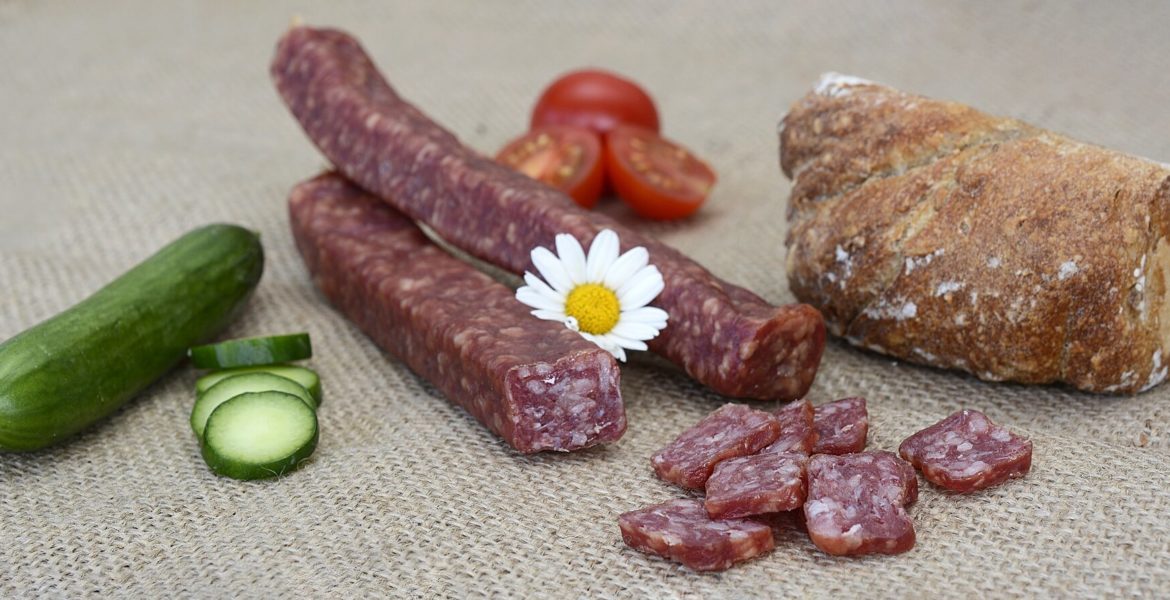

Swiss food it’s the Best
Very Delicious, and Helpful to those student who study culinary arts